ISSN ONLINE(2319-8753)PRINT(2347-6710)
ISSN ONLINE(2319-8753)PRINT(2347-6710)
S. Bhanu Pravallika1 and V. Lakshmi2
|
Visit for more related articles at International Journal of Innovative Research in Science, Engineering and Technology
Potable water is the most important ingredient in the making of conventional concrete and concrete is the most widely used material in the world next to water. Only 2.5% of the world’s water bodies are said to be of fresh water and the remaining constitute of sea water. According to the report of the World Meteorological Organization, more than half of the world’s population would not have enough drinking water by 2025. The construction officials in coastal areas have long been facing the challenge of building and maintaining durable concrete structures in a salt water environment. Gradual penetration of sea salts and the subsequent formation of expansive and leachable compounds lead to disintegration of structural concrete. Cement is the most costly and energy intensive component of concrete. The unit cost of concrete can be reduced as much as possible by partially replacing cement with fly ash. Fly ash is available in abundance as a by-product from thermal projects in India. Waste products like fly ash, (which otherwise is hazardous to the atmosphere, may be used as part partial replacement of cement with fly ash and the fly ash) when used in concretes have been known to have higher resistance to chloride ion penetration than concrete made with ordinary Portland cement. In the present study two grades of reference fly ash concrete M20, M25 were prepared using potable water for mixing and curing. The same grades of fly ash concrete were once again prepared using potable water for mixing and cured in sea water. Once again the same grades of fly ash concrete were prepared using sea water for mixing as well as curing. Investigation was carried out for fresh concrete properties and hardened concrete properties on specimens cured for 7, 28 & 90 days.
Keywords |
| Concrete, Fly ash, Super plasticizer, Conplast SP430, Crushing loads, Marine Environment |
INTRODUCTION |
| In order to save drinking water, the usage of seawater in concrete was investigated. The cement is the most costly and energy intensive component of concrete. The unit cost of concrete can be reduced as much as possible by partial replacement of cement with fly ash. The disposal of fly ash is one of the significant issues for environmentalists, as dumping of fly ash as waste material causes severe environmental problems. The utilisation of fly ash, instead of dumping it as a waste material, can be partly used on economic basis as partial replacement of cement was found to be more effective for structures which are constructed in the marine areas which are liable to be subjected to acidic attack of sea water. The IS Code indicates that sea water is not suitable for the mixing and curing of both plain and reinforced concrete in marine conditions. From the literature review it was found that concrete made with the sea water may have a higher early strength than normal concrete and the reduction in strength with age can be compensated by reducing the water–cement ratio. |
LITERATURE REVIEW ON FLYASH |
| Canon has stated that by adding fly ash to the extent of 15% by weight of cement in lean concrete (W/C=0.8) strength equal to the corresponding plane concrete within 90days was achieved. |
| C.Marthong, T.P.Agrawal in 2012 examined the Effect of Fly Ash Additive on Concrete Properties. This paper reports a comparative study on effects of concrete properties when OPC of varying grades 33, 43, 53 were partially replaced by fly ash. The main variable investigated in this study is variation of fly ash dosage of 10%, 20%, 30% and 40%. The compressive strength, durability and shrinkage of concrete were mainly studied. Test results shows that, inclusion of fly ash generally improves the concrete properties upto certain percent or replacement in all grades of OPC. |
| Deepa A. Sinha and Elizabeth George have designed M25 and M30 concrete mixtures with different percentages of ash substitution without any addition of chemical admixtures. It was found that not only the 28 and 90 days compressive strength but also the flexural strength and durability of fly ash concrete was satisfactory up to 50% fly ash substitution for cement. |
| Dhuraria has recorded that earlier strengths could be achieved in fly ash concrete by adjusting the various ingredients in such a way that the quantity of cement and fly ash in the final mix is more than the quantity of cement replaced. Fly ash concrete mix appeared drier than normal concrete mix but gets satisfactorily compacted with adequate vibrations. |
| Falah M. Wegian in 2010 examined the technical paper on effect of seawater for mixing and curing on structural concrete. In this article, the effects of mixing and curing concrete with seawater on the compressive, tensile, flexural and bond strengths of concrete were investigated. Concrete mixes were prepared by varying coarse aggregates, cement proportions and types. Six groups of concrete mixes were mixed and cured in fresh water, six groups were mixed and cured in seawater, while four groups were mixed with fresh water and cured in seawater. The compressive strength and subsequently the other related strengths of concrete were shown to increase for specimens mixed and cured in seawater at early ages up to 14 days, while a definite decrease in the respective strengths was observed for ages more than 28 days and up to 90 days. The reduction in strength increases with an increase in exposure time, which may be due to salt crystallization formation affecting the strength gain.Fly ash concrete in marine environment from csiro research report bre no (fly ash reference data sheet no.6.2 that fly ash blended cements are more suitable as binders for marine concrete structures than Portland cements. The use of fly ash blended cement in marine concrete will lead to higher resistance to chloride attack and good resistance to seawater damage. The overall results are longer service life in marine exposure. Hanh H. Pham1, Kien T. Tong1, Thanh T. Le1,2 examined the result of high strength concrete using fly ash for the structures in Vietnamese marine environment for sustainability reported that the research results of a high strength concrete (compressive strength of above 80 MPa) which has up to 35% cement content replaced by fly ash to be used for the structures in Vietnamese marine environment. The use of this concrete probably helps extend the service life of the infrastructures and also helps reduce a large amount of an industrial waste (fly ash) discharged from Vietnamese thermal power plants. This will be able to improve all three aspects of a sustainable construction which comprises economy, natural resource and environment. |
| Lovewell, Washa has stated that flyash concrete may develop some compressive strength as the corresponding plain concrete at earlier ages by over dosing the fly ash suitability. Md. Moinul Islam, Md. Saiful Islam, Md. Al-Amin and Md. Mydul Islam in 2012 examined that Suitability of sea water on curing and compressive strength of structural concrete as a part of durability study, this paper describes the effect of sea water on compressive strength of concrete when used as mixing and curing water. Concrete specimens were cast from four different grades and plain water as well as sea water was used as mixing water in making the test specimens. Test specimens were cured under sea water as well as plain water upto 180 days. Test results indicate that sea water is not suitable for mixing as well as curing of concrete. Concrete specimen made and cured with sea water exhibits compressive strength loss of about 10% compared to plain water mixed and cured concrete. |
| MYUNG SUG CHO and JAE MYOUNG NOH in 2011examined the assessment of properties and durability of fly ash concrete used in korean nuclear power plants presented that the quality suitability of fly ash manufactured in Korea is assessed and the basic physical properties of fly ash mixed concrete and its durability against primary causes of aging are verified through experimental methods. Because of the internal structure filling effect from the pozzolanic reaction of fly ash and the resulting improvements in mechanical performance in such areas as strength and salt damage resistance, the durability of fly ash mixed concrete is shown to be superior. It is judged that this result can be applied in measures not only for improving the safety of NPP structures in operation in Korea but also for implementing effective structure life management should extending the life of structures be needed in the future. |
| M. Collepardi examined the result of Concrete durability in a Marine Environment reported that this model is adopted to examine the durability of reinforced concrete structures exposed to a marine environment. At least three aggressive agents in sea water can cause deterioration of the reinforced concrete structures chloride, sulphate and alkali ions. The specific aggressive action of each aggressive agent is examined corrosion of the metallic bars caused by chloride ions, damage of the cement paste carried out by sulphate attack, and swelling disruption of concrete if alkali-reactive aggregates are present in the concrete. In order to prevent the damage of concrete structures exposed to a marine environment the following measures should be adopted: to reduce the water cement ratio by using super plasticizers; to employ cementations binders based on the combination of Portland cement with mineral addition such as fly ash and/or blast furnace slag. |
| O.O. Akinkurolere, cangru jiang and O.M. Shobola school of civil Engineering and Architecture, Wuhan University of Technology, Nigeria, West Africa in 2007 examined that the influence of salt water on the compressive strength of concrete reported that this study is aimed at investigation the effect of sea water as mixing or curing water on concrete compressive strength. This paper therefore presents the result and findings of an experimental research on the influence of salt water from Lagos lagoon, in Nigeria on concrete compressive strength. In the research, concrete cubes were cast with fresh and salt water using a 150×150×150 mm mould and a mix ratio of 1:2:4 by weight of concrete 0.6 watercement ratio were used. A total of 132 concrete cubes were made. Half of the cubes were made using fresh water and remaining half were made using salt water. They were cured in fresh and seawater respectively. The concrete cubes were tested for compressive strength at 7, 14, 21 and 28 days. The compressive strength of concrete is shown to be increased by the presence of salt or ocean salt in the mixing and curing water. The rate of strength gain is also affected when the concrete is cast with fresh water and cured with salt water and vice- versa. Mixing concrete with salt water and curing with salt- water increases the compressive strength rapidly and the strength was still increasing at 28 days. P. Kumar Mehta University of California, Berkeley, USA examined the high-performance, high-volume fly ash concrete for sustainable development reported that a brief review is presented of the theory and construction practice with concrete mixtures containing more than 50% fly ash by mass of the cementitious material. Mechanisms are discussed by which the incorporation of high volume of fly ash in concrete reduces the water demand, improves the workability, minimizes cracking due to thermal and drying shrinkage, and enhances durability to reinforcement corrosion, sulphate attack, and alkali-silica expansion. For countries like China and India, this technology can play an important role in meeting the huge demand for infrastructure in a sustainable manner. |
| Raima Lateefige has investigated the effect of seawater concentration, on mixing and curing, and compressive strength of concrete. The compressive strength of the cubes determined through crushing at 7, 14, 21 and 28 days respectively. The compressive strength of concrete cast with sea water showed an increase in strength at 7, 14, 21 and 28 days .A remarkable rapid increase was noted in concrete cubes cast with seawater and cured seawater at 7, 14, 21 and 28 days as well. At 7 days of curing, concrete cast with seawater and cured with seawater has attained strength of about 79% of the 28 days compressive strength of the control test. He found that 28 days, SS (cubes cast with seawater and cured with seawater) has attained strength of about 114% of 28 days compressive strength of control. |
MATERIALS AND METHODOLOGY |
A. Cement: |
| Portland pozzolana cement conforming to IS: 269-1976 and IS: 7031-1968 was used in this study. The cement is of 53grade and the tests conducted on cement are tabulated in Table No.1 |
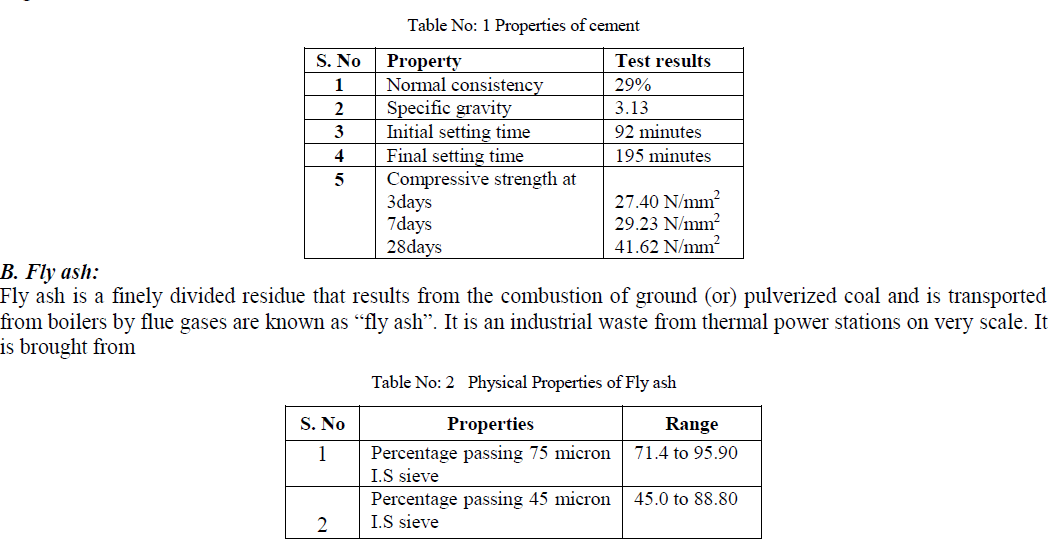 |
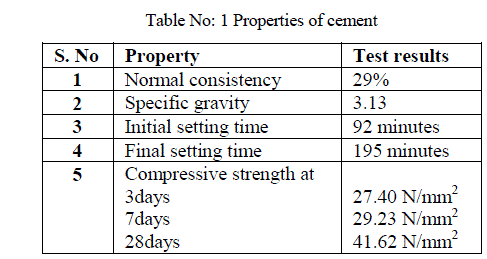 |
C. Fine aggregate: |
| The fine aggregate used is natural sand obtained from the river Godavari conforming to grading zone-II of table 3 of IS: 10262-2009. The results of various tests on fine aggregate are given in table. |
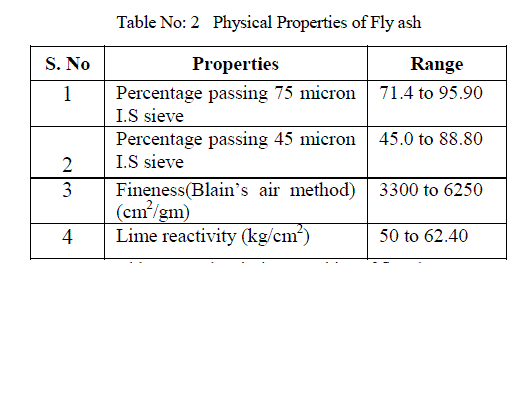 |
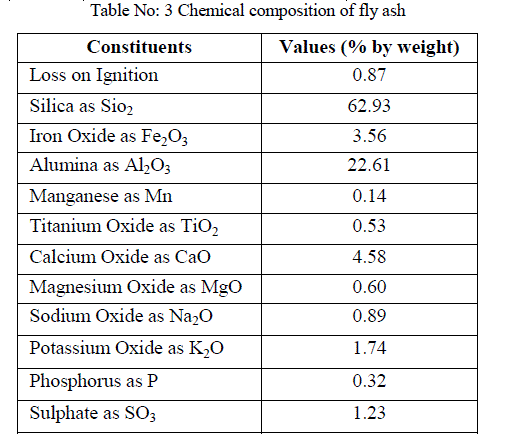 |
H. Mix design procedure: |
| In the present study two grades of reference fly ash concrete M20, M25 were prepared using potable water for mixing and curing. The same grades of fly ash concrete were once again prepared using potable water for mixing and cured in sea water. Once again the same grades of fly ash concrete were prepared using sea water for mixing. In these concrete was designed as per IS: 10262-2009. |
| In this experimental work, physical properties of materials used in the experimental work were determined. M20 and M25 grade of reference concrete was mixed and cured in potable water. |
CASTING AND TESTING DETAILS |
| 9 cubes, 9 cylinders and 9 beams conforming to IS: 516-1964 are casted after 24 hours the moulds were de-moulded and subjected to water curing. Before testing the cubes were air dried for 2 hours. Size of cubes 150*150*150mm, size of cylinders 150*300mm and size of beams 150*150*700mm. Crushing loads, split tensile strength and flexural strength were noted and average of 3 specimens was determined at 7days, 28days and 90days. The results are tabulated below. |
| FA: Fly ash concrete “M20” mixing and curing with potable water. |
| FB: Fly ash concrete “M20” mixing with potable water and curing with Sea water. |
| FC: Fly ash concrete “M20” mixing and curing with Sea water. |
| FD: Fly ash concrete “M25” mixing and curing with potable water. |
| FE: Fly ash concrete “M25” mixing with potable water and curing with Sea water. |
| FF: Fly ash concrete “M25” mixing and curing with Sea water. |
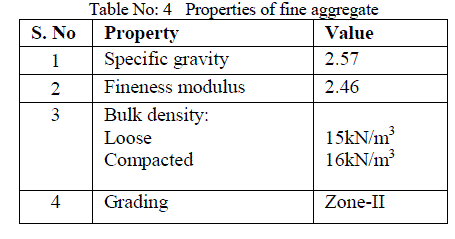 |
CONCLUSIONS |
| The slump has decreased by 3% and 6% for FB and FC when compared with FA. Hence the degree of workability was found to be good. There was no change in slump for FE, and the slump for FF has decreased by 3% when compared with FD. Hence the degree of workability was found to be good. The compaction factor has decreased by 1% and 2% for FB and FC mixes when compared with FA mix. Hence the degree of workability was found to be almost same. There was no change in compaction factor for FE where as the compaction factor for FF has decreased by 1% when compared with FD mix. Hence the degree of workability was found to be almost same. FB and FC mixes reached their respective target mean compressive strengths at 28 days. But when compared with FA, they were found to be less by 6% and 18% respectively. FE and FF mixes reached their respective target mean compressive strengths at 28 days. But when compared with FD, they were found to be less by 11% and 14% respectively. The compressive strengths of FB and FC has increased by 6% and 4% at 90 days respectively when compared with their strength at 28 days. The compressive strength of FB and FC at the age of 90 days has reduced by a percentage of 8% and 22% respectively when compared with the strength of FA. The compressive strength of FE and FF has increased by 15% and 3% at 90 days respectively when compared with their strength at 28 days. The compressive strength of FE and FF at the age of 90 days has reduced by a percentage of 5% and 20% respectively when compared with the strength of FD. Flexural strength (At 28 days) of FB&FC has reduced by 2% and 18% respectively when compared with FA. Flexural strength (at 28 days) of FE&FF has reduced by 6% and 12% respectively when compared with FD. The split tensile strength of FB & FC (at 28 days) has reduced by 2% and 27% respectively when compared with FA. The split tensile strength of FE & FF (at 28 days) has reduced by 6% and 20% respectively when compared with FD. The work was carried on plain cement concrete, partially replacing cement with an optimized value of 25% fly ash. At the age of 90 days, though the compressive strength values obtained are found to be good, it was observed that the bonding in concrete is very poor. This can be attributed to the mixing and curing done with sea water. The presence of fly ash has reduced the formation of laitance and honey combing when compared to the results of literature review. |
References |
|